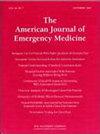Development and validation of the discharge severity index for post-emergency department hospital readmissions
IF 2.7
3区 医学
Q1 EMERGENCY MEDICINE
引用次数: 0
Abstract
Introduction
Hospital readmissions often result from a combination of factors, including inadequate follow-up care, poor discharge planning, patient non-adherence, and social determinants of health (SDOH) that impact access to healthcare and follow-up resources, many of which are beyond provider control. Enhanced post-discharge strategies, including risk stratification, are essential. This study aims to develop and validate the Discharge Severity Index (DSI) to predict readmission risk and optimize resource allocation for effective follow-up care.
Methods
This single-center retrospective study analyzed ED visits from the Medical Information Mart for Intensive Care IV, dividing the data into derivation (75 %) and validation (25 %) cohorts. Univariate analyses were conducted on factors commonly available for most discharges, including patient age, the latest vital signs recorded, medical complexity, and ED length of stay (LOS). Multiple logistic regression (MLR) was employed to identify independent risk factors of patients revisiting the ED within a week and being subsequently admitted to the hospital. Adjusted parameter estimates from the MLR were used to develop a predictive model.
Results
Among 229,920 patients discharged from the ED, 1.92 % were readmitted. The analysis identified seven variables correlated with this outcome, with six significant risk factors pinpointed through MLR: age above 65, heart rate over 100, and oxygen saturation below 96 % (assigned 1 point each), along with having more than five active medications administered during the hospital stay or a LOS exceeding 3 h (assigned 2 points each). Using these scores, we categorized patients into five DSI groups, reflecting escalating readmission risk from DSI 5 (lowest risk) to DSI 1 (highest risk): DSI 5 (0; OR: 1.0), DSI 4 (1–2; OR: 3.49), DSI 3 (3–4; OR: 8.44), DSI 2 (5–6; OR: 11.65), and DSI 1 (>6; OR: 14.63). The seven-day readmission rates were comparable between the development and validation cohorts. For instance, for DSI 1, the rates were 5.16 % in the development cohort and 4.67 % in the validation cohort. For DSI 2, the rates were 4.16 % and 4.04 %, respectively.
Conclusion
This study seeks to develop and validate the DSI, proposing its effectiveness as a tool for healthcare providers to categorize patients by their risk of post-discharge admission from the ED. The utilization of this tool has the potential to lead to a more informed allocation of resources after discharge.
急诊科医院再入院出院严重程度指标的建立与验证
再入院往往是由多种因素共同造成的,包括随访护理不足、出院计划不佳、患者不遵医嘱以及影响医疗保健和随访资源获取的健康社会决定因素(SDOH),其中许多因素超出了提供者的控制范围。加强出院后战略,包括风险分层,是必不可少的。本研究旨在建立并验证出院严重程度指数(DSI),以预测再入院风险并优化资源分配,以实现有效的随访护理。方法本单中心回顾性研究分析重症监护室医疗信息市场的急诊就诊情况,将数据分为衍生组(75%)和验证组(25%)。对大多数出院常见的因素进行单变量分析,包括患者年龄、最新记录的生命体征、医疗复杂性和急诊科住院时间(LOS)。采用多元logistic回归(MLR)确定患者一周内再访急诊科并随后入院的独立危险因素。利用MLR调整后的参数估计值建立预测模型。结果229920例急诊科出院患者中有1.92%再次入院。分析确定了与该结果相关的七个变量,通过MLR确定了六个重要的危险因素:年龄超过65岁,心率超过100,血氧饱和度低于96%(每项1分),以及在住院期间使用超过五种有效药物或LOS超过3小时(每项2分)。使用这些评分,我们将患者分为五个DSI组,反映了从DSI 5(最低风险)到DSI 1(最高风险)的再入院风险升级:DSI 5 (0;Or: 1.0), dsi 4 (1-2;Or: 3.49), dsi 3 (3 - 4;Or: 8.44), dsi 2 (5-6;OR = 11.65), DSI = 1 (>6;或者:14.63)。7天再入院率在开发组和验证组之间具有可比性。例如,对于DSI 1,开发队列的发生率为5.16%,验证队列的发生率为4.67%。对于DSI 2,患病率分别为4.16%和4.04%。本研究旨在开发和验证DSI,提出其作为医疗保健提供者根据出院后从急诊室入院的风险对患者进行分类的工具的有效性。该工具的使用有可能导致出院后更明智的资源分配。
本文章由计算机程序翻译,如有差异,请以英文原文为准。
求助全文
约1分钟内获得全文
求助全文
来源期刊
CiteScore
6.00
自引率
5.60%
发文量
730
审稿时长
42 days
期刊介绍:
A distinctive blend of practicality and scholarliness makes the American Journal of Emergency Medicine a key source for information on emergency medical care. Covering all activities concerned with emergency medicine, it is the journal to turn to for information to help increase the ability to understand, recognize and treat emergency conditions. Issues contain clinical articles, case reports, review articles, editorials, international notes, book reviews and more.

 求助内容:
求助内容: 应助结果提醒方式:
应助结果提醒方式:


